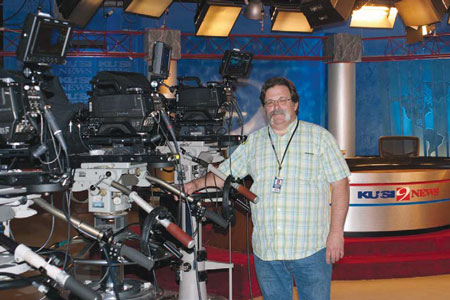KUSI Boosts News Production With Hitachi
SAN DIEGO—KUSI is an independent television station owned by McKinnon Broadcasting that produces 60 hours of live newscasts weekly for the San Diego market.

Fred Swift with Hitachi Z-HD6000 in KUSI’s studio Recently, the entry-level studio cameras we purchased when we first upgraded our news productions to HD had become dated. They were increasingly time-consuming and costly to maintain. I also wasn’t satisfied with the video quality we received from those cameras.
There were also some operational challenges. Our existing cameras used a cumbersome, multicore camera cable, which wasn’t conducive to how frequently we move our cameras around during newscasts. We also needed to build our own cable assemblies to power our teleprompters and for intercom connectivity. In addition, we were forced to mount our teleprompters above the lenses. Our talent disliked this, so our news director wanted to ensure that our next cameras allow throughthe- lens teleprompting.
CHECKING ALL THE BOXES
We started looking at Hitachi cameras at the NAB Show, and purchased five Z-HD6000 cameras. While the camera’s price-performance value and comprehensive feature set were key considerations, the picture quality produced by its 2/3-inch, 2.6 megapixel MOS sensors and advanced digital signal processing won us over. When our station’s owner saw the quality produced by the Z-HD6000 side-byside with our existing cameras, the decision was easy.
The Z-HD6000’s built-in features not only simplified wiring and power requirements, they also made the cameras easy to integrate and deploy; we installed and commissioned all five cameras in just seven hours. Our Listec teleprompters run off the extra power provided by the camera head, and the camera’s built-in communication channels integrate easily with our RTS intercom system. I was originally concerned about potential lighting issues with through-the-lens teleprompting, but with the Z-HD6000’s that isn’t a problem. The camera’s sensitivity is absolutely incredible.
The cameras are connected by SMPTE fiber to Hitachi CU-HD500 camera control units with RU-1200JY remote controls. The move to fiber connectivity has given us the production flexibility we sought. It is now much easier to move the cameras around our studio—often several times per hour— freeing us to produce the news we want to see. The reliability of the fiber connectivity has also been stellar, even with our handheld operators running in and out the door to our outside patio set.
EXCEEDING EXPECTATIONS
Most importantly, our quality goals have been met and even exceeded. The overall picture quality is far better than our previous cameras, and it’s incredible how good the Z-HD6000 makes our talent look. The color flexibility and user-friendly painting abilities let us achieve exactly the look we want, while the camera’s eight recallable scene memories are ideal for quick picture shading when switching between our daytime and nighttime talent.
The professional video industry's #1 source for news, trends and product and tech information. Sign up below.
In my opinion, any station looking to replace their first-generation HD cameras should check out the Hitachi Z-HD6000. The cameras provide excellent value, quality and performance, and are easy to install.
Fred Swift is chief engineer at KUSI-TV and a recipient of a NATAS Silver Circle award for more than 25 years of outstanding contribution to the San Diego broadcast community. He can be reached atswift@kusi.com.
For more information on Hitachi Kokusai Electric America, please visitwww.hitachikokusai.usor call 855-891-5179.
